30 Tint on Car: Benefits and Legality in the US
Car window tinting is a popular choice among car owners for various reasons. One such option is the 30 tint, which offers a balance of privacy, protection, and aesthetics. In this article, we will explore the benefits of using a 30 tint on car windows and delve into the legality of this tint in the United States.
- Enhanced privacy: The 30 tint provides an added level of privacy, allowing you to feel more comfortable inside your car.
- Protection against UV rays: Car window tint acts as a barrier against harmful UV rays, helping protect your skin and interior from damage.
- Glare reduction: The 30 tint reduces glare from the sun, ensuring better visibility and a more comfortable driving experience.
- Improved aesthetics: Window tinting enhances the overall appearance of your car, giving it a sleek and stylish look.
While the benefits of using a 30 tint are evident, it is crucial to understand the legality of this tint in the United States. Each state has specific regulations regarding the allowable levels of tint for different windows, including front side windows, back side windows, rear windows, and windshields. Adhering to these laws is essential to avoid potential penalties or legal trouble.
Key Takeaways:
- Car window tinting using a 30 tint offers enhanced privacy, protection against UV rays, glare reduction, and improved aesthetics.
- It is important to understand the legality of 30 tint on car windows in different states across the US.
- Each state has specific regulations regarding the allowable levels of tint for different windows.
- Adhering to window tint laws is crucial to avoid potential penalties or legal trouble.
Understanding Window Tint Percentages
When it comes to window tint on car windows, understanding the tint percentages is essential. Window tint percentages refer to the amount of visible light transmission (VLT) allowed through the tinted film. The lower the percentage, the darker the tint.
Different states in the US have specific regulations regarding the allowable levels of tint for various windows, including front side windows, back side windows, rear windows, and windshields. These laws are in place to ensure visibility and safety on the road.
Window Tint Shade Options:
Window tint shade options range from light to dark, with varying VLT percentages. Here are some common options:
- Light Tint: Light tint options typically have a higher VLT percentage, allowing more light to pass through the windows. This choice can provide a subtle tint and some heat reduction without compromising too much visibility.
- Medium Tint: Medium tint options offer a balance between privacy and visibility. These tints typically have a moderate VLT percentage, providing a noticeable shade while still maintaining good visibility.
- Dark Tint: Darker tint options have a lower VLT percentage, reducing the amount of light that passes through the windows. This choice offers enhanced privacy and a sleek appearance but may impact visibility, particularly at night or in adverse weather conditions.
It’s important to consult the specific car window tinting laws in your state to ensure compliance with the acceptable VLT percentages for each window.
Car Window Tinting Laws:
Car window tinting laws vary from state to state in the US. Here is a summarized overview of some common regulations:
| Window Type | Most Common VLT Limit |
|---|---|
| Front Side Windows | Varies between 20% and 70% |
| Back Side Windows | Varies between 20% and 70% |
| Rear Windows | Varies between 20% and 70% |
| Windshields | Varies between 70% and 90% |
Note: The specific percentages mentioned are approximate and may vary depending on the state. It’s crucial to research and familiarize yourself with the exact regulations in your state regarding car window tinting.
“Understanding the VLT percentages allowed for window tint is essential to ensure compliance with the law and maintain visibility and safety on the road.” – Car Window Tinting Expert
Dark Tint and State Laws
Many car owners prefer a dark tint for their windows due to its sleek and stylish appearance. However, it’s important to note that each state has its own regulations regarding the darkness level allowed for automotive window tint. Before opting for a dark tint, it’s crucial to check the specific laws in your state to ensure compliance.
In most cases, states have established limits on how dark the tint can be. These limits are typically measured by the Visible Light Transmission (VLT) percentage, which indicates the amount of light that can pass through the car tint film. The lower the VLT percentage, the darker the tint.
When it comes to dark tint and state laws, it’s essential to consider the following:
- Specific Darkness Level Limits: Each state has its own specified darkness level limit, which indicates the maximum VLT percentage that is allowed for car window tinting. Some states may have stricter limits, while others may allow a darker tint for specific windows, such as the rear windows. It’s crucial to familiarize yourself with these regulations to avoid any potential legal issues.
- Exceptions and Exemptions: Some states may have exceptions or exemptions for certain individuals or vehicles. For example, law enforcement vehicles or vehicles used for medical purposes may be allowed to have a darker tint. It’s important to check if any exemptions apply in your state and what criteria must be met to qualify for them.
- Enforcement and Penalties: It’s also important to note that enforcement of window tint laws varies from state to state. While some states may have stricter enforcement and penalties for non-compliance, others may have more lenient approaches. However, it’s always best to adhere to the regulations to avoid any potential consequences and ensure road safety.
By understanding the specific regulations and limitations in your state, you can make an informed decision about the darkness level of your automotive window tint. To help illustrate the varying darkness level limits across different states, we’ve compiled a table highlighting some examples:
| State | Front Side Window Tint Limit | Rear Side Window Tint Limit | Rear Window Tint Limit |
|---|---|---|---|
| California | 70% VLT or lighter | Any darkness level | Any darkness level |
| Texas | 25% VLT or lighter | Any darkness level | Any darkness level |
| New York | 70% VLT or lighter | 70% VLT or lighter | 70% VLT or lighter |
It’s important to note that the table above provides just a few examples, and the regulations may change or vary from state to state. We recommend consulting your local Department of Motor Vehicles (DMV) or relevant authorities for the most up-to-date and accurate information regarding window tint regulations in your specific area.
Remember, compliance with window tint laws not only ensures that you remain within the legal boundaries but also contributes to the safety and visibility of both yourself and other drivers on the road.
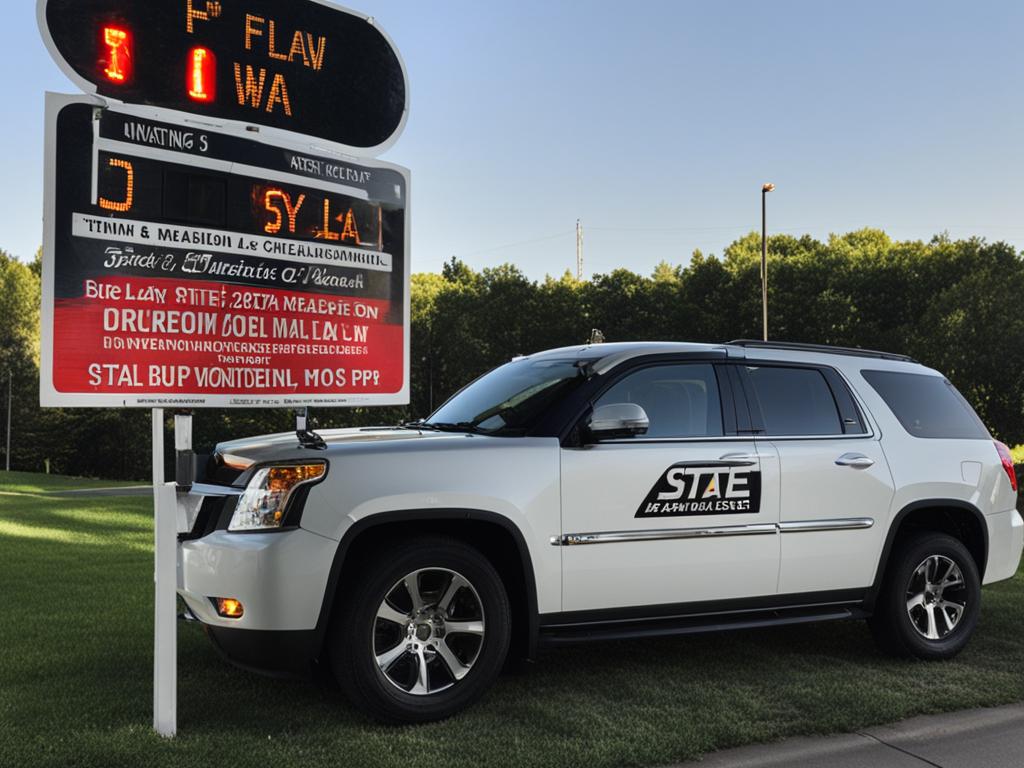
“Understanding the regulations surrounding dark tint is essential for every car owner. By complying with state laws, you can enjoy the benefits of a stylish tint while ensuring the safety of yourself and others.”
Window Tint Terminology
When it comes to understanding window tint regulations and effectiveness, familiarizing yourself with window tint terminology is essential. The following terms play a significant role in determining the legality and impact of window tint:
- VLT Percentage: The Visible Light Transmission (VLT) percentage refers to the amount of light allowed to pass through the tinted film. It measures the darkness or tint level of the windows, with lower percentages indicating darker tints.
- Front-Side Window Tint: This term refers to the tint applied to the driver and passenger side windows. Different states have specific regulations on the VLT percentage allowed for front-side window tint.
- Back-Side Window Tint: The back-side window tint refers to the tint applied to the rear passenger windows, located behind the driver and front passenger seats. These windows often have different regulations regarding the allowable darkness level.
- Rear Window Tint: The rear window tint is applied to the larger window at the back of the vehicle. Specific regulations exist for the VLT percentage allowed for the rear window tint.
- Windshield Shade Band: The windshield shade band is a tint strip typically applied at the top of the windshield. It helps reduce glare from the sun. However, laws governing the windshield shade band can vary by state.
- Reflectivity: Reflectivity refers to the ability of the window tint to reflect light. Some tints have reflective properties that help reduce heat and glare.
Understanding these terms will assist you in selecting the appropriate window tint and ensuring compliance with the regulations in your state.
Window Tint Laws by State
It is important to familiarize yourself with the window tint laws in your state to ensure compliance with the regulations. Each state has its own specific laws regarding car window tinting, including permissible Visible Light Transmission (VLT) percentages for different windows and restrictions on reflectivity. By understanding the laws in your state, you can make informed decisions about professional car window tinting.
State Window Tint Laws Overview
- Alabama: Front side windows must allow more than 32% VLT; back side and rear windows can have any darkness level.
- California: Front side windows must allow more than 70% VLT; back side and rear windows can have any darkness level.
- Florida: Front side windows must have at least 28% VLT; back side and rear windows can have 15% VLT or darker.
- Texas: Front side windows must have at least 25% VLT; back side and rear windows can have any darkness level.
- New York: Front side windows must have at least 70% VLT; back side and rear windows can have any darkness level.
These are just a few examples of state window tint laws, and it is important to note that regulations can vary. Be sure to check the specific laws in your state to ensure compliance with car window tinting requirements.
Why Professional Car Window Tinting Matters
When it comes to window tinting, it is crucial to choose a professional service provider. Professional car window tinting ensures that the tint is applied correctly, maintaining adherence to state laws and regulations. Additionally, professionals have the expertise to help you select the appropriate tint shade that aligns with your needs and preferences while complying with the law.
“With professional car window tinting, you can enjoy the benefits of enhanced privacy, reduced glare, and protection against harmful UV rays, all while staying within the legal limits.” – [Insert Quote Attribution]
The Consequences of Non-Compliance
Failing to comply with car window tinting laws can result in consequences such as fines, citations, or even having to remove the tint entirely. It is better to be aware of and adhere to the regulations to avoid these potential troubles. By choosing professional car window tinting, you can ensure that your vehicle meets the legal requirements, protecting you from any legal consequences.
Common Tint Laws in Select States
When it comes to window tint laws, different states across the United States have their own regulations and specifications. Here are some examples of common tint laws in select states:
California
In California, the front side windows of vehicles must allow at least 70% Visible Light Transmission (VLT). However, the back and rear windows are allowed to have any darkness level.
Florida
In Florida, the front side windows of vehicles must have a VLT of 28% or lighter. On the other hand, the rear half of the vehicle can have a VLT of 15% or lighter.
Texas
When it comes to tint laws in Texas, the front side windows of vehicles must have a VLT of 25% or lighter. Similar to California, the back and rear windows in Texas can have any darkness level.
Understanding these common window tint laws in select states can help car owners ensure compliance with the regulations. Remember, it’s crucial to always check the specific tint laws in your state to avoid potential fines or legal consequences.
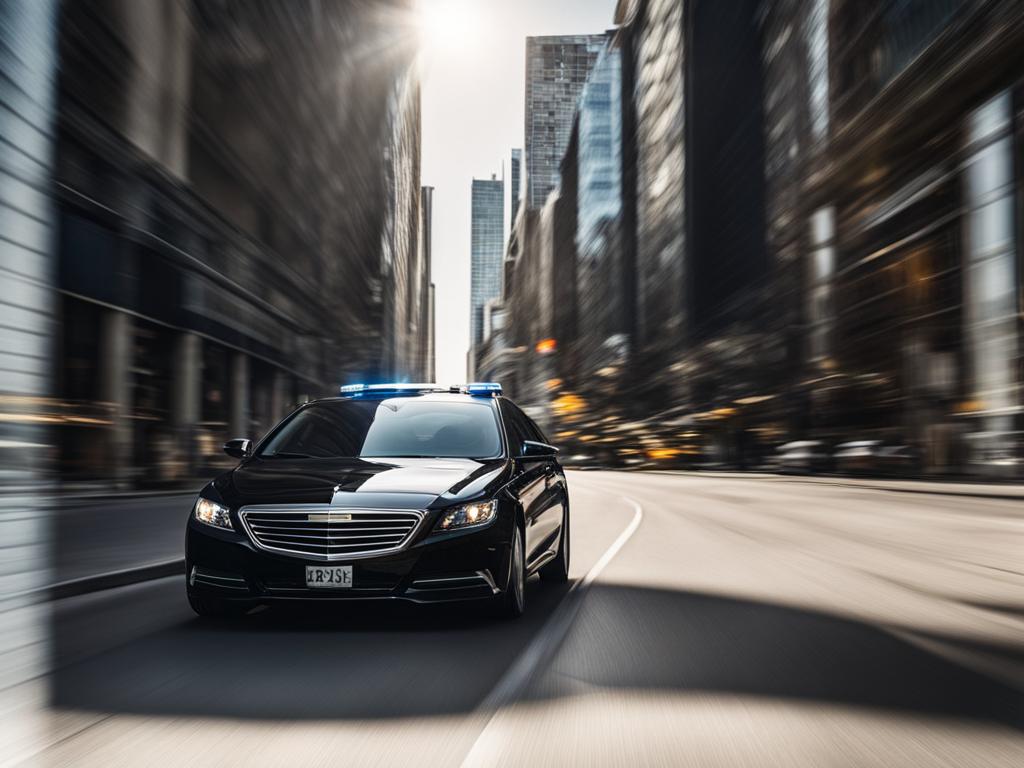
Understanding Medical Exemptions for Tinted Windows
While strict regulations govern the darkness level of window tints in most states, some offer medical exemptions for individuals with specific light-sensitive conditions. These medical exemptions allow individuals to have darker tinted windows to limit their exposure to light and protect their health.
Conditions such as Lupus, which causes extreme sensitivity to sunlight, may qualify for a medical exemption for window tint. By obtaining the necessary documentation and certification from a medical professional, individuals can legally tint their windows beyond the standard limits imposed by state laws.
Medical exemptions for tinted windows can significantly improve the quality of life for individuals with light-sensitive conditions, providing them with necessary protection from harmful UV rays and reducing discomfort caused by excessive sunlight.
It’s important to note that the eligibility criteria for medical exemptions may vary from state to state. Individuals seeking a medical exemption for window tint should check with their respective state authorities and follow the proper procedures to ensure compliance.
Benefits of Medical Exemptions for Tinted Windows
Medical exemptions for window tint offer several benefits for individuals with light-sensitive conditions:
- Reduced exposure to harmful UV rays:
- Improved comfort and well-being:
- Enhanced privacy:
Tinted windows with medical exemptions provide enhanced protection against the sun’s ultraviolet (UV) rays, which can exacerbate symptoms and cause discomfort for light-sensitive individuals.
Darkened windows help reduce glare and harsh light, creating a more comfortable environment for individuals with light-sensitive conditions.
Tinted windows offer increased privacy, allowing individuals with light-sensitive conditions to go about their daily activities without feeling exposed to the public.
By understanding and availing themselves of medical exemptions for tinted windows, individuals with light-sensitive conditions can enjoy improved quality of life and better manage their health.
The Impact of Tinted Windows on Visibility and Safety
While tinted windows offer benefits such as enhanced privacy and protection from the sun, it is important to consider the impact on visibility and safety. Dark tint can reduce visibility, especially at night, in foggy conditions, or in poorly lit areas. It is crucial to strike a balance between personal preferences and safety when choosing the darkness level for your window tint.
When considering professional car window tinting, it’s essential to understand the laws and regulations regarding tint darkness in your state. Different states have specific car window tinting laws that dictate the permissible levels of visible light transmission (VLT) allowed through the tinted film on car windows. These laws are in place to ensure adequate visibility for the driver and overall safety on the road.
A window tint that is too dark can significantly impair your ability to see clearly while driving. It can reduce your vision of the road, pedestrians, and other vehicles, especially in low-light situations. This decreased visibility can increase the risk of accidents and compromise your safety and the safety of others on the road.
It’s important to remember that the darkness of the tint applied to each window of your car may have specific legal limits set by your state. For example, front side windows may have different darkness restrictions compared to back side windows and rear windows. Additionally, some states may have restrictions on the amount of reflectivity allowed in the tint.
Striking the right balance between privacy, sun protection, and visibility is crucial when choosing the darkness of your car window tint. Opting for a lighter tint can still provide benefits such as reducing glare and protecting against harmful UV rays, while ensuring adequate visibility for safe driving.
| State | Front Side Windows | Back Side Windows | Rear Windows | Windshields |
|---|---|---|---|---|
| California | 70% VLT or lighter | No restrictions | No restrictions | No restrictions |
| Florida | 28% VLT or lighter | No restrictions | 15% VLT or lighter | No restrictions |
| Texas | 25% VLT or lighter | No restrictions | No restrictions | No restrictions |
Note: The table above provides examples of window tint laws in select states and is not an exhaustive list. It is important to refer to the specific regulations in your state for accurate information.
When it comes to tinted windows, it’s crucial to prioritize safety while enjoying the benefits they offer. Familiarize yourself with the car window tinting laws in your state, and consult with a professional car window tinting service to ensure compliance and the best solution for your needs.
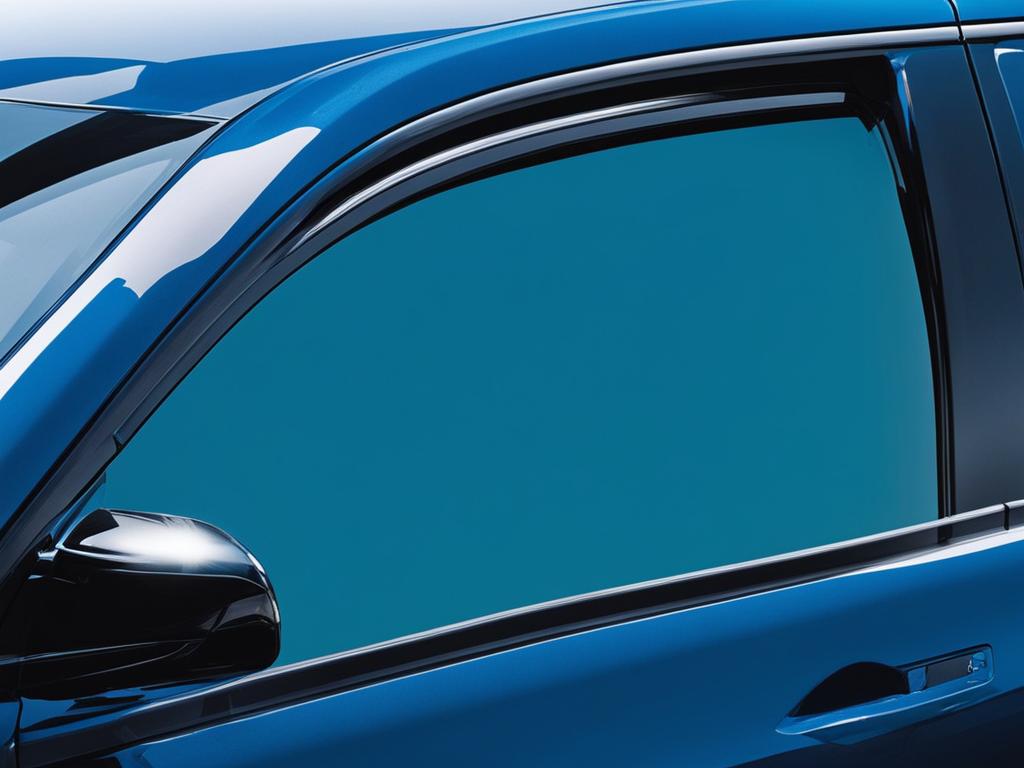
Can You Get Pulled Over for Tinted Windows?
The legality of window tint and the likelihood of getting pulled over varies by state. If the tint on your windows does not comply with the state’s regulations, you may be subject to being pulled over and receiving a citation or fine. It is important to be aware of the car window tinting laws in your state and ensure compliance to avoid any potential issues.
Each state has its own specific regulations regarding the allowable levels of tint for different windows in a car. These regulations are in place to maintain visibility and safety on the road. By adhering to these laws, you can avoid attracting unwanted attention from law enforcement and potential legal consequences.
“Failure to comply with car window tinting laws can result in citations or fines.”
To determine if your tinted windows are compliant, you should familiarize yourself with the window tint shade options and VLT (visible light transmission) percentages allowed in your state. Understanding the permissible levels of tint for front side windows, back side windows, rear windows, and windshields is crucial. Different states have different tint shade options and VLT requirements, so it is important to consult the specific laws in your state.
Here is an example of car window tinting laws in select states:
| State | Front Side Windows | Back Side Windows | Rear Windows | Windshield |
|---|---|---|---|---|
| California | 70% VLT or higher | No restrictions | No restrictions | 4-inch shade band allowed |
| Texas | 25% VLT or higher | No restrictions | No restrictions | 5-inch shade band allowed |
| Florida | 28% VLT or higher | 15% VLT or higher | 15% VLT or higher | Non-reflective above the AS-1 line |
It is important to note that these regulations may change over time, so it is always recommended to verify the current car window tinting laws in your state before making any decisions about window tints for your vehicle.
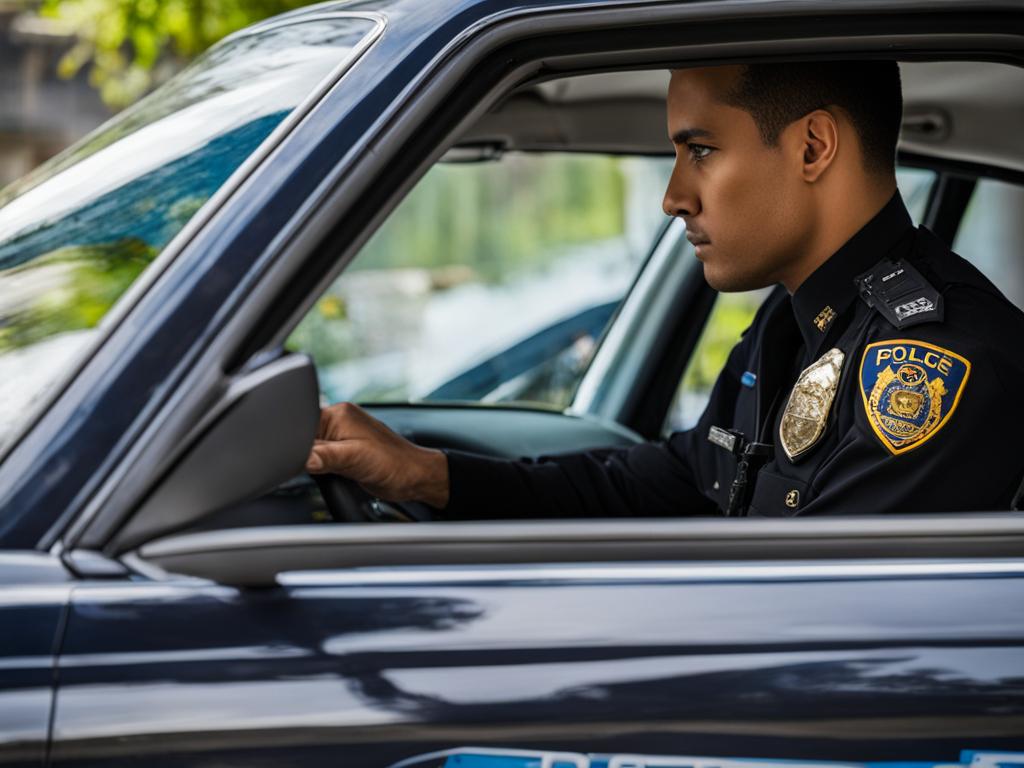
Penalties for Non-Compliance with Tint Laws
Failure to comply with car window tinting laws can result in various penalties, which vary by state. It is important to understand the potential consequences to avoid unnecessary fines or legal trouble.
For first-time offenders, some states may issue a warning or a “fix-it ticket.” This gives you the opportunity to address the tint violation by removing or adjusting the tint to meet the legal requirements.
However, repeat offenses can lead to more severe penalties. Fines may be imposed, which can range from a few hundred dollars to several thousand dollars. In some cases, multiple offenses may result in requirements to remove the tint entirely or face suspension of vehicle registration.
It is crucial to familiarize yourself with the specific tint laws in your state to ensure compliance. Ignorance of the law is not a valid defense, and being proactive can save you from potential legal and financial consequences.
To help you understand the potential penalties in your state, here is a table showcasing the general consequences for non-compliance:
| State | Penalties for Non-Compliance |
|---|---|
| California | First offense: Fix-it ticket and potential fine. Subsequent offenses: Increasing fines and possibly vehicle impoundment. |
| Florida | First offense: Non-moving violation with a fine. Subsequent offenses: Increasing fines and potentially vehicle impoundment. |
| Texas | First offense: Fine and the requirement to remove tint. Subsequent offenses: Increasing fines and potential license suspension. |
Remember, these penalties are general examples, and the actual consequences may vary depending on the circumstances and the discretion of law enforcement officers.

Is Limo Tint Legal?
Limo tint, also known as a very dark or blacked-out tint, is not generally legal on car windows. Each state has its own regulations regarding the darkness level allowed for tinted windows, and limo tint often exceeds these limits. It is important to adhere to the specific regulations in your state and avoid using excessively dark tint.
When it comes to window tint, the key is to strike a balance between style, privacy, and legality. While many car owners are drawn to the sleek and mysterious look of limo tint, it is crucial to understand the laws in your state before applying such a dark tint to your car windows.
“Dark tint, such as limo tint, may obstruct visibility for both the driver and law enforcement officers, posing a safety concern on the road.”
Law enforcement officers often rely on being able to see inside a vehicle for identification purposes during traffic stops or other situations. Additionally, excessively dark tint can significantly reduce visibility, especially at night or in low-light conditions, increasing the risk of accidents.
While some states may allow slightly darker tint for certain windows, it is best to consult the specific regulations in your state to ensure compliance. Adhering to the tint laws not only helps maintain the safety and visibility of your vehicle but also avoids potential penalties or legal issues.
To get a clearer picture of the darkness levels allowed in different states, refer to the table below:
| State | Front Side Windows | Back Side Windows | Rear Windows |
|---|---|---|---|
| California | 70% VLT or above | No restriction | No restriction |
| Florida | 28% VLT or above | 15% VLT or above | No restriction |
| Texas | 25% VLT or above | No restriction | No restriction |
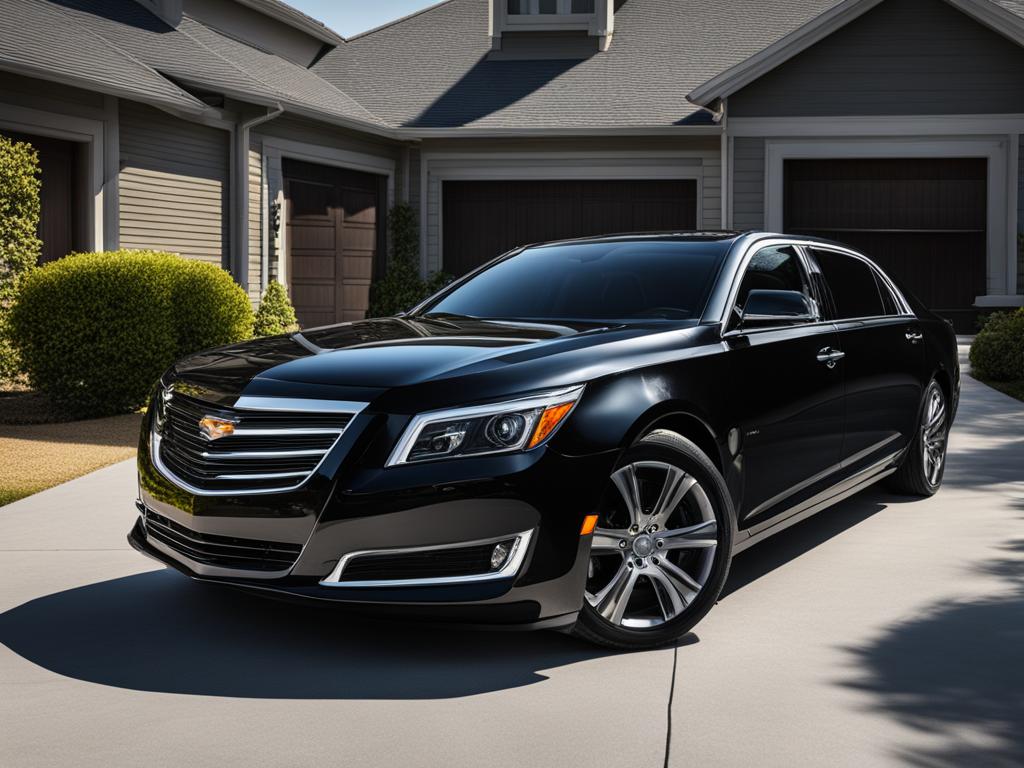
Remember, it is essential to familiarize yourself with your state’s specific regulations and choose a window tint that complies with the laws. By doing so, you can enjoy the benefits of tinted windows while ensuring the safety and legality of your vehicle.
States Allowing 5% Tint
While many states have specific regulations regarding car window tinting, there are some states that allow a 5% tint on specific windows, typically for back-side passenger cars. However, it is crucial to check the specific regulations in your state, as not all states permit this level of darkness. Adhering to the car window tinting laws in your state is essential to avoid potential penalties or legal issues.
Before considering a 5% tint, it is important to understand the potential consequences and ensure compliance with the regulations. The following table highlights whether 5% tint is allowed in select states:
| State | 5% Tint Allowed? |
|---|---|
| California | No |
| Florida | No |
| Texas | Yes |
Please note that the information provided in the table is subject to change, and it is crucial to refer to the latest laws and regulations in your state before deciding on a 5% tint. Being aware of the car window tinting laws in your state and ensuring compliance will help you stay on the right side of the law.
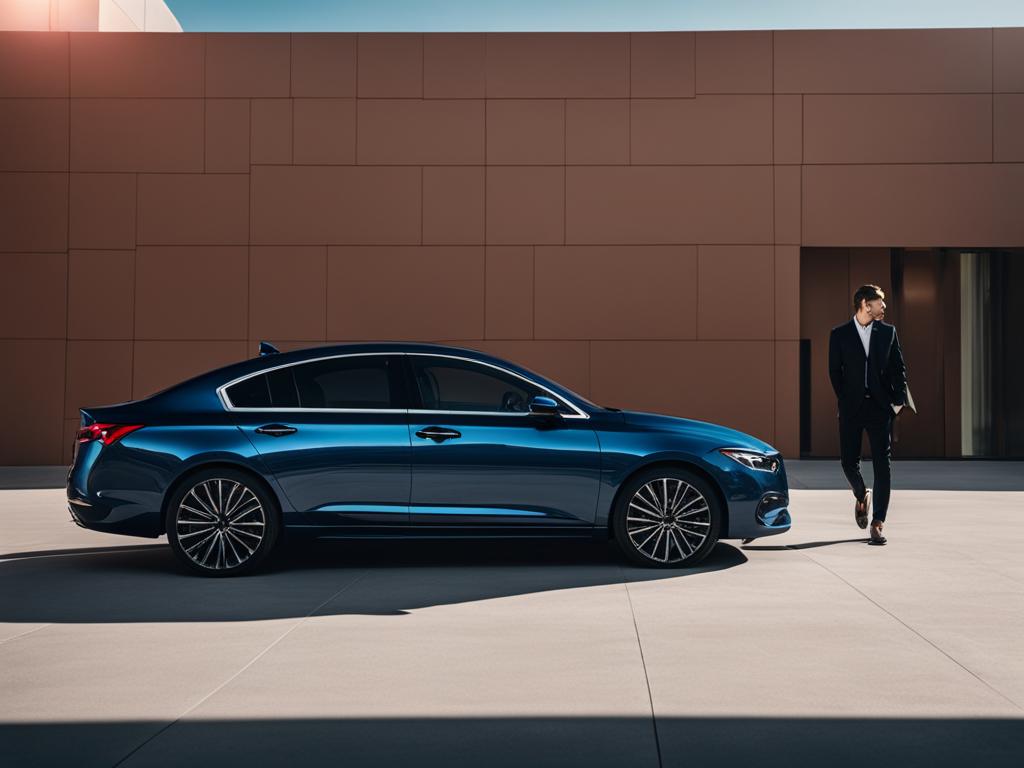
Understanding Car Window Tint Percentages
Before exploring the states that allow 5% tint, it is important to have a clear understanding of car window tint percentages. The tint percentage refers to the amount of visible light transmission (VLT) allowed through the tinted film on car windows. Tint percentages have a direct impact on the level of darkness and privacy provided by the tint.
Car window tint percentages typically range from 5% to 90%, with 5% being the darkest and 90% allowing the most light transmission. Darker tints offer more privacy, while lighter tints provide a clearer view both from the inside and outside of the vehicle.
Each state has its own specific car window tinting laws, which dictate the allowed tint percentages for different windows of the vehicle. These laws help maintain visibility and safety on the road by ensuring that drivers have a clear view of their surroundings.
If you are considering a 5% tint for your car windows, it is essential to check the regulations in your state. Even if 5% tint is permitted, there may be restrictions on which windows can have this level of darkness. Always prioritize compliance with the car window tinting laws to avoid any legal consequences.
Medical Exemptions and Waivers for Window Tint
For individuals with certain medical conditions that require limited exposure to light, some states provide exemptions and waivers for window tint. These exemptions typically require a medical certification and can allow for darker tinted windows to accommodate the specific needs of the individuals.
Medical exemptions are designed to help individuals with conditions like Lupus or other light-sensitive conditions maintain a level of comfort and safety while driving. By allowing darker tinted windows, these exemptions offer a practical solution for those who require heightened protection against harmful UV rays and excessive sunlight.
To qualify for a medical exemption, it is important to follow the proper procedures and obtain the necessary documentation. Typically, this involves obtaining a medical certificate or statement from a qualified healthcare professional outlining the specific medical condition and the need for limited exposure to light.
Once the necessary documentation is obtained, individuals can then apply for the medical exemption through the appropriate channels in their state. It is important to thoroughly understand the requirements and guidelines set forth by the state to ensure eligibility for the exemption.
Medical exemptions are an important consideration for individuals with medical conditions that necessitate limited exposure to light. By working within the framework of state regulations and obtaining the proper documentation, these individuals can benefit from the increased privacy, UV protection, and reduced glare that window tinting provides.
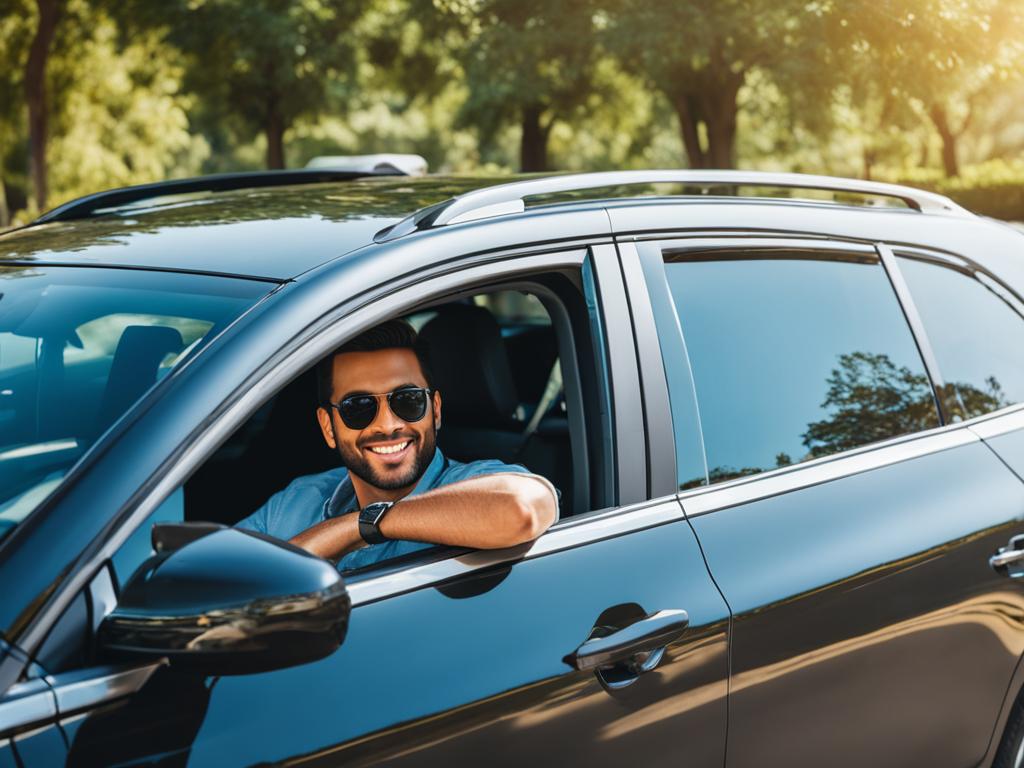
The Importance of Following Window Tint Laws
Window tint laws are in place to ensure safety, visibility, and compliance with the regulations in each state. By adhering to these laws, you can maintain clear and unobstructed vision while driving, allow law enforcement to see inside the vehicle, and avoid potential penalties or legal issues. Understanding and following the window tint laws in your state is crucial for a hassle-free and legal driving experience.
Benefits of Following Window Tint Laws
“Adhering to window tint laws not only keeps you on the right side of the law but also offers several key benefits for drivers and passengers.”
- Clear and Unobstructed Vision: Following the specified window tint percentages ensures that your visibility is not compromised while driving. This is especially important during nighttime, inclement weather, or in low light conditions.
- Law Enforcement Cooperation: By conforming to the tint laws, you are helping law enforcement officers maintain their ability to see inside your vehicle, promoting safety and security.
- Avoiding Penalties: Non-compliance with window tint laws can result in fines or citations. By following the regulations, you can avoid unexpected penalties and unnecessary legal entanglements.
- Insurance Coverage: In the event of an accident or insurance claim, violating window tint laws could potentially impact your insurance coverage. Adhering to the laws ensures you meet all necessary requirements for your coverage to remain valid.
Understanding State-Specific Window Tint Laws
Each state has its own set of window tint laws, which specify the permissible levels of window tint darkness and reflectivity. These laws often vary depending on the type of window being tinted, such as front side windows, back side windows, rear windows, and windshields. To ensure compliance, drivers should familiarize themselves with the specific tint laws in their state.
Consequences of Non-Compliance
“Failure to follow window tint laws can have various consequences, including potential fines, risks to personal safety, and legal issues.”
Penalties for non-compliance with window tint laws vary by state. Common consequences can include monetary fines, requirements to remove the tint, or even vehicle impoundment. Moreover, driving with overly dark or illegal window tint can attract the attention of law enforcement and potentially create a negative interaction.
| State | Front Side Windows | Back Side Windows | Rear Windows | Windshields | Reflectivity |
|---|---|---|---|---|---|
| California | 70% VLT or higher | Any darkness allowed | Any darkness allowed | 4-inch non-reflective band | No restrictions |
| Florida | 28% VLT or higher | 15% VLT or higher | 15% VLT or higher | Non-reflective band on top | No restrictions |
| Texas | 25% VLT or higher | Any darkness allowed | Any darkness allowed | Non-reflective band on top | No restrictions |
Safe and Legal Tinting
To ensure safe and legal window tinting, consider the following:
- Consult a Professional: Seek the services of a professional car window tinting provider who is well-versed in the local laws and regulations. They can provide expert advice on the appropriate tint darkness and ensure proper installation.
- Review State-Specific Guidelines: Before tinting your car windows, review the specific guidelines outlined by your state’s laws. Understanding the limitations and allowances will help you make informed decisions about the appropriate tint darkness for your vehicle.
- Quality Tint Products: Choose high-quality window tint films that comply with your state’s regulations and do not compromise visibility. Investing in professional-grade tint products ensures longevity and the desired benefits without compromising safety.
By adhering to the window tint laws in your state, you can enjoy the benefits of tinted windows while staying on the right side of the law. Understanding the regulations, following state-specific guidelines, and seeking professional assistance will help you achieve a safe, legal, and visually appealing tint for your vehicle.
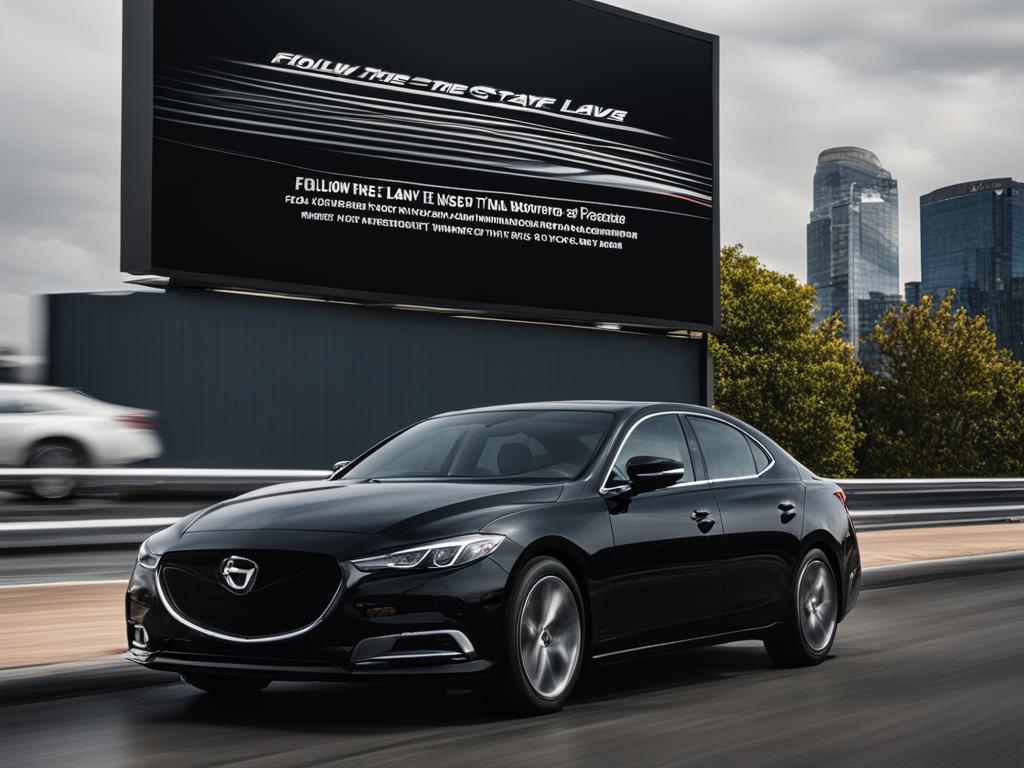
Conclusion
Window tinting offers a range of benefits for car owners, including increased privacy, protection against harmful UV rays, and an improved aesthetic. However, it is crucial to understand and adhere to the window tint laws in your state to avoid legal consequences. By familiarizing yourself with window tint percentages, state regulations, and the importance of visibility and safety, you can make informed decisions when tinting your car windows.
When considering window tinting, keep in mind that different states have specific regulations regarding the darkness level allowed for window tint. It is important to check the specific laws in your state to ensure compliance. Darker tints can reduce visibility, especially at night or in poor lighting conditions, so striking a balance between personal preference and safety is crucial.
By following the window tint laws, you help maintain clear visibility for yourself and law enforcement, promoting safety on the road. Additionally, understanding the legality of window tinting protects you from potential fines or penalties for non-compliance.
Remember, while window tint can enhance the overall appeal of your car and provide benefits, it is essential to prioritize compliance with the law and prioritize safety. Stay informed about the window tint laws in your state, consult professionals, and make choices that align with both your personal preferences and legal requirements.
FAQ
What are the benefits of 30 tint on a car?
30 tint on car windows offers enhanced privacy, protection against UV rays, glare reduction, and improved aesthetics.
Are there laws regarding window tint percentages?
Yes, different states have specific regulations regarding allowable levels of tint for car windows to ensure visibility and safety on the road.
Can I have a dark tint on my car windows?
Each state has its own laws regarding the darkness level allowed for window tint. It is important to check your state’s specific regulations before getting a dark tint.
What window tint terminology should I know?
Understanding terms such as VLT percentage, front-side window tint, back-side window tint, rear window tint, windshield shade band, and reflectivity is crucial for determining the legality and effectiveness of the tint.
What are the window tint laws by state?
Each state has its own specific window tint laws, including permissible VLT percentages for different windows and reflectivity restrictions. You should check the laws in your state for compliance.
What are some common tint laws in select states?
In California, front side windows must have at least 70% VLT, while back and rear windows may have any darkness level. In Florida, front side windows must have a VLT of 28% or lighter, while the rear half of the vehicle can have a VLT of 15% or lighter. Texas requires front side windows to have a VLT of 25% or lighter, while back and rear windows have no specific darkness limit.
Can I get a medical exemption for window tint?
Some states provide medical exemptions for individuals with light-sensitive conditions. These exemptions allow for darker tinted windows for medical reasons, but certain procedures and documentation are required.
Does tinted windows affect visibility and safety?
Dark tint can reduce visibility, especially at night or in poorly lit areas. It is important to strike a balance between personal preferences and safety when choosing a window tint darkness.
Can I get pulled over for tinted windows?
The likelihood of getting pulled over for tinted windows depends on the legality of the tint in your state. If your tint does not comply with the regulations, you may be subject to a citation or fine.
What are the penalties for non-compliance with tint laws?
Penalties for non-compliance with tint laws vary by state and can include warnings, “fix-it tickets,” fines, or requirements to remove the tint.
Is limo tint legal?
Limo tint, referring to a very dark or blacked-out tint, is generally not legal on car windows as it often exceeds the darkness limits set by state regulations.
Which states allow 5% tint?
Some states allow 5% tint on specific windows, usually for back-side passenger cars only. However, the specific regulations vary, and not all states permit this level of darkness.
Are there exemptions for medical conditions requiring window tint?
Some states provide exemptions and waivers for individuals with certain medical conditions that require limited light exposure. Proper procedures and documentation are necessary to qualify for a medical exemption.
Why is it important to follow window tint laws?
Following window tint laws ensures safety, visibility, compliance, and avoids potential penalties or legal issues. Compliance also allows law enforcement to see inside the vehicle for security purposes.
Can tinted windows be completely dark?
No, each state has specific regulations regarding the darkness level allowed for tinted windows. It is important to adhere to these regulations and avoid using excessively dark tint.
What is the conclusion about car window tinting laws?
Understanding and following car window tinting laws in your state is crucial to ensure legality and avoid any potential issues. Compliance with these laws helps maintain visibility, safety, and prevents penalties or legal trouble.




